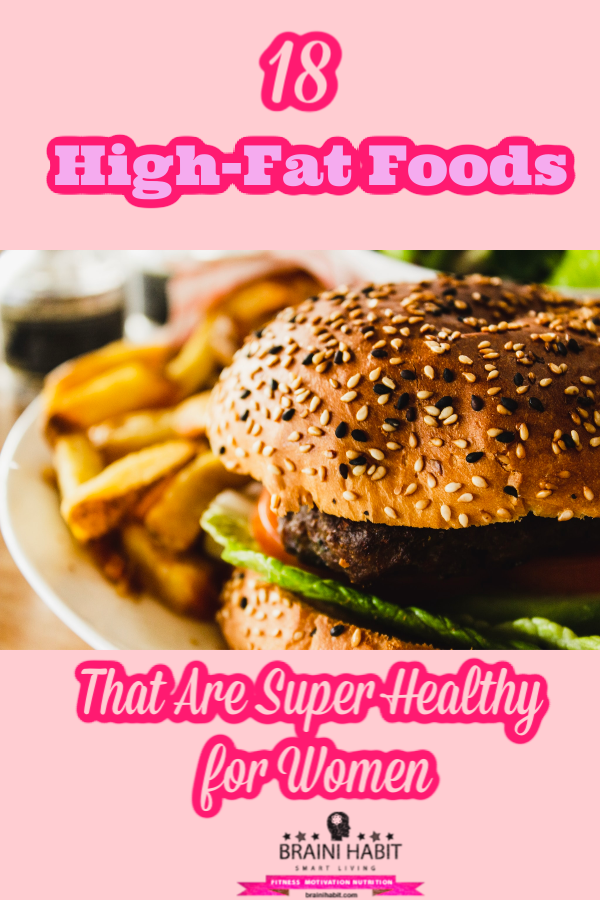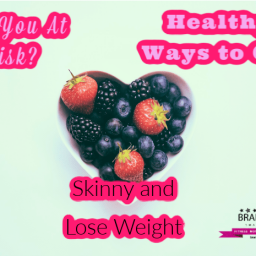More and more people are starting to understand that consuming fat, in particular, is not a reason for obesity.
Overeating with fats is just as likely to lead to weight gain, as overeating with carbohydrates.
While some artificial fats might have negative effects on human health, most natural healthy fats are quite healthy and do not contribute to obesity when consumed in moderation.
In this article, we will talk about 18 healthy fat sources, and other benefits they can provide.

Which fats are healthy and which are not?
There are 4 common groups of fats in our diet – saturated, monounsaturated, polyunsaturated and hydrogenated(trans) fats.
Overall, evidence about saturated fats and health risks is mixed.
The main sources of saturated fats are animal products such as meat, eggs, dairy and some plant products like coconut and palm oils.
One of the studies showing detrimental effects of consuming saturated fats was of the American Heart Association.
According to it, lowering the intake of dietary saturated fat and replacing it with polyunsaturated vegetable oil leads to reduced incidence of heart diseases by approximately 30% (1).
The result was similar to the reduction achieved by statin treatment.
Another literature review from 2017 did not find a reduction in cardiovascular diseases after replacing saturated fats with polyunsaturated ones (2).
A meta-analysis of multiple cohort studies found no association between saturated fat intake and risk of cardiovascular diseases (3).
Higher intake of trans (hydrogenated) fatty acids, however, was associated with a greater risk of cardiovascular diseases.
And while the information for saturated fats is diverse, the data for the detrimental effect of hydrogenated fats is compelling (4).
There is evidence for a direct correlation between consuming hydrogenated oils and cardiovascular risk and mortality.
Mono-unsaturated fatty acids (MUFA) on the other hand are most beneficial for health.
They are shown to greatly benefit cardiovascular health and reduce the risk of heart diseases (5, 6).
Diets rich in MUFA are shown to reduce the risk of type 2 diabetes (7).
The best sources of MUFA are olives (and olive oil), avocadoes, nuts, seeds and even some types of meat and eggs.
Take-Away:
Monounsaturated fats are proven to be healthy when consumed in moderation, while the data for saturated ones are mixed. Artificially hydrogenated (trans) fats should be avoided entirely as they are proven to be unhealthy.
Some healthy fats are essential for the normal function of our bodies
The polyunsaturated fatty acids (PUFA) are Omega 3 and Omega 6.
They are also called essential – our organism cannot produce them on its own so we need to consume it with our diet.
Both of them are used for the production of mediators that regulate inflammation in our bodies.
Omega 3 is a combination of 3 acids – ALA (alpha-linolenic acid), DHA (docosahexaenoic acid) and EPA (eicosapentaenoic acid).
ALA is contained in plant sources. It is used as a precursor in the body for the production of DHA and EPA – the biologically active forms.
DHA and EPA are called long-chain omega 3. They are less common, as the only good food source is fatty-fish.
The benefits of omega 3 fatty acids are numerous, mainly related to their anti-inflammatory effects. A meta-analysis shows that they reduce many of the factors of inflammation (8).
Furthermore, studies show that foods rich in omega 3 are beneficial for autoimmune and inflammatory diseases (9).
The group of diseases includes rheumatoid arthritis, Crohn’s disease, ulcerative colitis, psoriasis, lupus erythematosus, multiple sclerosis, migraine, asthma, hypertension, and depression (10, 11, 12, 13).
The omega 6 fatty acids are mostly consisting of linoleic acids (LA) which get converted to arachidonic acid (AA) in our body.
AA has a rather pro-inflammatory effect compared to EPA or DHA (14).
However, studies show that consuming too much LA or AA with the diet does not increase the factors of inflammation in the body (15).
This is why it is much more important to increase the consumption of omega 3 and to maintain a proper ratio between omega 3 and omega 6 (16).
Omega 6 to omega 3 should not higher than 4:1.
Take-Away:
Omega 3 and omega 6 are both essential fatty acids. For optimal health, it is important to consume enough omega 3 and maintain optimal omega 6 to omega 3 ratio.
The 18 healthy high-fat foods are:
1. Salmon
Salmon is one of the best sources of fats and fat-soluble vitamins such as vitamin D.
It contains plenty of omega 3 fatty acids which are essential and very commonly insufficient in most diets.
Salmon can also help with providing satiation and aiding weight loss.
Studies show that the combination of high-protein and omega 3 greatly modulates satiety (17).
Vitamin D is also one of the most insufficient nutrients in our diets. Scientists compare its deficiency to a pandemic (18).
Normally we produce vitamin D in our skin through exposure to direct sunlight.
However, during seasons like winter when there is not enough solar radiation, our best source is diet.
Not enough of the vitamin causes rickets in children and osteoporosis in adults.
Furthermore, evidence suggests that chronic vitamin D deficiency may have serious adverse consequences in the long term (19).
They include increased risk of hypertension, multiple sclerosis, cancers of the colon, prostate, breast, and ovary, and type 1 diabetes.
Cooked salmon has less than 200 kcals, while it provides more than 25 grams of protein and 8 grams of healthy fats per 100 grams of the product.
Take-Away:
Salmon is a healthy source of omega 3 fatty acids and vitamin D.
2. Canned tuna
Another type of fish that also contains omega 3 fatty acids is tuna.
It is very commonly consumed as canned food, which can make tuna a great addition to many salads or it can be consumed as a snack.
However, due to water pollution, fish can accumulate mercury in their bodies, in the form of methylmercury which is highly toxic.
Some types of fish like sharks, which feed on other fish, concentrate more mercury in them compared to others.
While some species of tuna might also accumulate it, light tuna, for example, has levels within safe limits (20).
A hundred grams of canned light tuna in olive oil, is less than 200 kcals, while it provides more than 25 grams of protein and 8 grams of healthy fats.
Take-Away:
Canned tuna can be a healthy snack rich in protein and omega 3. However, we have to be careful what tuna we consume since some types have higher amounts of mercury.
3. Avocado
Unlike most fruits, avocado is full of fats. These fats are healthy unsaturated ones, similar to olive oil.
Avocadoes are also rich in water and fiber, so despite the fat content, they are not very calorie-dense.
The fat contained helps with the absorption of other nutrients when combined in salads such as carotenoids and other antioxidants (21).
This is why avocadoes are best used as an addition to different salads or meals.
A hundred grams of avocado has just 160 kcals, 15g of fats and 9 grams of carbohydrates.
Take-Away:
Avocado is a healthy fruit rich in monounsaturated fatty acids, which in combination with salads can improve the absorption of fat-soluble vitamins.
4. Cheese
A study showed that over 40% of the US population does not get enough calcium from their diet (22).
Calcium is crucial for maintaining optimal bone health and aids bone healing after fractures. The best dietary source for calcium is dairy products, especially cheese.
Most cheeses have fat and calories contents around 250-500kcals and 15-35 grams of fats per 100 grams.
Consumption of dairy products is also proven to influence positively weight control as well as blood cholesterol and blood sugar (23).
Despite previous concerns, systematic analyses have found no connection between the risk of cancer and the consumption of dairy (24).
Take-Away:
Cheese and other types of full-fat dairy products are a good source of healthy fats, proteins, and calcium.
5. Eggs
Eggs have whites and yolks. The egg white is entirely made of protein, while the yolk contains protein, fats, cholesterol, and vitamins.
The yolk is actually a small nutrition bomb – it contains many vitamins and minerals such as iron, vitamins A, E, K, and D.
Each yolk contains almost 5 grams of healthy fats, 3 grams of protein and 55 kcals.
The yolk also has a lot of cholesterol but it is not proven to be harmful when consumed in moderation.
A huge meta-analysis involving more than 28,000 people proved that consuming an egg every day with yolk does not raise health risks (25).
Another study also found that consuming 3 eggs with yolks daily for 13 weeks does not raise cholesterol in healthy participants since the endogenous synthesis is downregulated (26).
However, for people who already have health problems and disturbed endogenous synthesis, it is best to restrict dietary cholesterol as well.
Take-Away:
Egg yolks are very dense in healthy fats and nutrients such as iron, vitamins A, E, K, and D. Despite their high cholesterol content they do not raise the cardiovascular risks.
6. Dark chocolate
Dark chocolate has 30 grams of fats and over 600 kcals per 100 grams of the product.
Just like any other chocolate, it should be used in moderation because it is very caloric and does not provide much satiation – a combination that promotes obesity.
However, unlike other sweets, dark chocolate has lots of antioxidants.
The health benefits are numerous, including a reduction in blood pressure and cardiovascular mortality, and reducing oxidative stress (27).
It is also a great substitute for other much unhealthier sweets.
One of the best ways to avoid sweet snacks is to simply replace them with dark chocolate.
It is not only healthier but also less sweet, which reduces the chance of eating too many calories out of it.
Take-Away:
Dark chocolate is a great substitute for other sweets, as it is less likely to overeat with it, plus it is full of antioxidants.
7. Full-fat yogurt
Yogurt is healthy and well-balanced food. Full-fat yogurt contains 3 grams of protein and 4 grams of fats.
It is also rich in probiotics that provide multiple health benefits – normal digestion, improved immune function, healthier skin and reduced risk of some diseases (28).
Probiotics are friendly bacteria such as Lactobacillus that are also normally found in your gut and aid digestion.
Yogurt also appears to be a great snack for weight loss (29).
Like other dairy products, yogurt contains calcium, which is beneficial for bone health.
Take-Away:
Full-fat yogurt is great overall food with a balanced ratio of nutrients, calcium, and probiotics.
8. Olive oil
Olive oil is arguably the healthiest fat in the world. Most of it the 18-carbon long oleic acid, which is a monounsaturated fatty acid.
Olive oil has powerful anti-inflammatory effects, mainly due to the polyphenol called oleocanthal (30).
Some researchers even compare it to the effect of ibuprofen (31).
Furthermore, olive oil decreases blood pressure and helps reduce hypertension (32).
The benefits of the Mediterranean diet in terms of cardiovascular and metabolic risk are to a large extent due to the extensive use of olive oil in the diet.
Still, olive oil is quite caloric – 100g contains almost 900 kcals, so it should be used sparingly.
Take-Away:
Olive oil is one of the healthiest types of fats out there, but still it has to be used in moderation in order to prevent weight gain.
9. Flaxseed oil
Flaxseeds are quite rich in fiber, protein, and omega 3 (ALA).
There is evidence that flaxseed oil consumption aids in the reduction of cardiovascular disease, atherosclerosis, diabetes, cancer, arthritis, osteoporosis, autoimmune and neurological disorders (33).
Flax protein helps in the prevention and treatment of heart disease and in supporting the immune system.
It should be used in moderation as it is highly caloric – almost 900 kcals per 100 grams.
Take-Away:
Flaxseed oil is a healthy vegetable oil that is very rich in omega 3 fatty acids. It has to be used in moderation due to its high-calorie content.
10. Butter
Butter has been demonized for years as full of cholesterol and saturated fats, which increase cardiovascular risk.
However, new evidence suggests that there is no connection between the normal consumption of butter and conditions such as heart disease and diabetes (34).
It is also a healthy source of vitamins A and E. Adequate amounts of vitamin A reduce the risk of night blindness and acne and support a healthy immune system and bone health.
Vitamin A also supports healthy growth and reproduction. However, it should be avoided during pregnancy as it might be harmful to the unborn baby (35).
100 grams of butter contains at least 80 grams of fat and over 700 kcals.
Take-Away:
Despite being labeled as unhealthy, studies show that butter is a safe option for a fat source when used in moderation as well as rich in nutrients such as vitamin A.
11. Chia
Research indicates that components of chia seeds have a beneficial effect on the blood lipid profile – levels of good and bad cholesterol (36).
This is partially due to the high amount of soluble fiber, which also improves blood sugar control in diabetic patients.
Furthermore, the high fiber content of chia seeds leads to forming a gel-like substance in your stomach and provides fullness and satiation (37).
Chia seeds contain 30 grams of healthy fats and 500 kcals per every 100 grams of the product.
Take-Away:
Chia seeds have a combination of healthy fats and high fiber content which provides great satiety in addition to multiple health benefits related to blood sugar and cholesterol levels.
12. Walnuts
Walnuts have multiple health benefits, some of which are due to its healthy fat content, such as omega 3 (38).
Furthermore, walnuts are richer in antioxidants than any other nut (39).
The anti-inflammatory effect of walnuts is further increased by the content of polyphenols.
They contain 65 grams of fats and 650 kcals of energy per 100 grams. However, evidence shows around 20% of the calories are not fully absorbed by the human gut (40).
Take-Away:
Walnuts are the richest in antioxidants compared to all types of nuts. They also contain omega 3.
13. Almonds
Almonds are quite rich in fat and calories. They contain around 50 grams of healthy fats and over 600 kcals per 100 grams.
Even small amounts of almonds, however, are very rich in nutrients. They have large amounts of vitamin E and magnesium.
Vitamin E has beneficial antioxidant and anti-inflammatory effects (41).
It prolongs the life of cells in the human body and has beneficial effects on skin and hair.
Take-Away:
Almonds are rich in vitamin E and magnesium, as well as good quality protein and fiber.
14. Pumpkin seeds
Pumpkin seeds are full of healthy fats and valuable nutrients such as zinc, magnesium, and antioxidants (42).
A hundred grams of roasted seeds contain almost 50 grams of healthy fats and 600 kcals.
They are a good source of magnesium, which is one of the most deficient minerals in our diet.
For example, a study performed on the US population found out that 48% have inadequate intake (43).
This can be detrimental to overall health, as magnesium is important for the function of every cell in our bodies, especially in the nervous, cardiovascular, and musculoskeletal systems.
A deficiency can lead to irregular heartbeat and muscle cramps (44).
Magnesium is proven to help against high blood pressure (45), improve sleep and reduce the risk of depressions (46).
Take-Away:
Pumpkin seeds are a healthy fat source, as well as quite rich in zinc and magnesium.
15. Poultry and other sources of white meat as healthy fats
White meat is a great source of quality protein and fats. A combination of fats and protein is proven to improve satiation and can aid in weight loss.
Chicken breasts, for example, contain over 30 grams of protein and 8 grams of fats, more than half of which are monounsaturated.
Most of the fat content is in the skin, while the protein is in the meat itself (47).
Take-Away:
Poultry is rich in both protein and fats, which makes it great for satiation and weight loss.
16. Lean red meat
Lean meat can be not just poultry, but also beef, lamb or even pork with the fat trimmed off.
These types of meat still contain relatively high amounts of fats, some of which are actually unsaturated.
For example, around 50% of the fat content in pork comes from monounsaturated fatty acids.
Meat is a great source of protein, which provides satiation and essential amino acids.
Red meat has accumulated a lot of bad rep because it has been previously shown that it might increase the risk of cancer and heart diseases (48).
However, lean meats and even red meat that is trimmed of all visible fat are not proven to be increasing the risk for heart diseases (49).
A very recent study now finds that there is a very weak correlation between the general consumption of red meat and the risk of cardiovascular diseases (50).
However, processed red meat should be avoided as there are proven mechanisms in which it can increase the risk of cancer.
Take-Away:
Lean red meat has been proven by recent studies to be a safe dietary option. It is also a great source for protein and fats and can be used in a weight loss diet as a healthy food option.
17. Tofu
Tofu is food made from soy milk, which is very common in vegan diets as a protein source.
It has a great nutritional profile – 8 grams of good quality proteins, and 5 grams of healthy fats, for just 76 kcals per 100 grams of the product.
Tofu and soy are rich in isoflavones, which have numerous health benefits (51).
For example, reducing the risk of atherosclerosis and heart disease (52).
Furthermore, soy products might improve glycemic control in diabetic patients (53).
Despite all soy and tofu being genetically modified, there is no scientific evidence that consuming GMO is harmful to human health (54).
Take-Away:
Tofu is a great vegetarian source of protein and fats, while the content of isoflavones provides additional health benefits.
18. Sunflower seeds
A hundred grams of sunflower seeds contain more than 50 grams of fat and almost 600 kcals.
The fats are healthy mono and polyunsaturated fatty acids, like omega 6.
Furthermore, it contains good protein, magnesium, and vitamin E.
Studies involving over 6,000 participants show that consumption of sunflower seeds improves markers for inflammation (55).
Thus, it might be helpful for managing chronic inflammation. It also improves the management of diabetes and hypertension.
However, sunflower seeds should be consumed in moderation since they are quite caloric.
Take-Away:
Sunflower seeds contain healthy amounts of omega 6, vitamin E, protein and magnesium.
To sum everything up on healthy fats for women
When used in moderation, dietary fat sources can be a healthy option, as a lot of them contain other important nutrients such as minerals and fat-soluble vitamins.
So fats are even essential for our bodies, and we have to consume them in sufficient quantities from our diets in order to stay healthy.
The only type of fats that have to be avoided are the artificially produced trans fats, via hydrogenation of vegetable oils.





